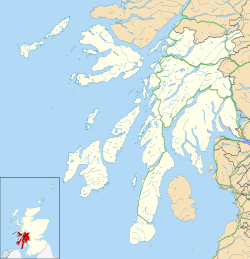Kilchurn Castle
| Kilchurn Castle | |
|---|---|
| Argyll and Bute in Scotland | |
 Kilchurn Castle | |
| Coordinates | 56°24′13″N 5°1′44″W / 56.40361°N 5.02889°W |
| Type | Castle |
| Site information | |
| Owner | Historic Environment Scotland |
| Open to the public | Yes |
| Condition | Ruined |
| Website | Historic Scotland |
| Site history | |
| Built | 15th century |
| Built by | Clan Campbell |
| In use | 15th century-1760 |
| Fate | Renovated frequently, destroyed by lightning |
Kilchurn Castle (
History
The Campbells of Glenorchy were the most powerful cadet branch of the
Sir Colin's son, Sir Duncan Campbell of Glenorchy, built the 'laich hall' - a single-storey dining hall built along the inside of the south curtain. Sir Duncan was one of the many Scottish nobles killed at the
In 1681 Sir John Campbell, 5th Baronet, was created Earl of Breadalbane and Holland. He took advantage of the turbulence of the times, negotiating with Jacobite rebels at the same time as serving William III. In 1693 he promoted a scheme to pacify the Highlands, and as part of this he began conversion of Kilchurn into a modern barracks, capable of housing 200 troops. His main addition was the three-storey L-shaped block along the north side. In 1714, on the death of Queen Anne, Breadalbane held a conference of Jacobites at Kilchurn, and he subsequently joined the Earl of Mar's Jacobite rising of 1715. Following the failure of the rising he returned home to find pro-government members of his household had turned Kinchurn and Finlarig over to Alexander Campbell of Fonab, to whom Breadalbane was obliged to surrender in February 1716. He remained under house arrest at Taymouth until his death the next year.[8] Kilchurn was also used as a government garrison during the 1745 Jacobite rising.[3] The Campbells attempted, unsuccessfully, to sell Kilchurn to the government after they moved in 1740 to the reconstructed Taymouth Castle.
In 1760, the castle was badly damaged by lightning and was completely abandoned; the remains of a turret of a tower, still resting upside-down in the centre of the courtyard, attest to the violence of the storm. The castle was unroofed by 1770.[9] J. M. W. Turner painted the castle on one of his tours of Scotland in the early 19th century.[10] In 1817 the water level in Loch Awe was altered, so that the castle now stands on a long peninsula. MacGibbon and Ross surveyed the castle in about 1887, after which restoration works appear to have altered some of the castle's original features.[6]
The ruin is now in the care of Historic Environment Scotland, and is open to the public during the summer. Access is either by boat from Lochawe pier, or on foot from the A85 near Dalmally. The access is under the railway viaduct that crosses Loch Awe, and access is sometimes restricted by higher-than-usual levels of water in the loch, which turn the site into a temporary island.[11] The castle is a scheduled monument.[9]
Gallery
-
Kilchurn Castle by David Farquharson, 1901
-
Kilchurn Castle reflecting on Loch Awe
-
Kilchurn Castle, viewed from Loch Awe Hotel to the west
-
Engraving of Kilchurn Castle by William Miller, 1846
-
Carved lintel over the door
-
Late 19th-century postcard view
-
Courtyard
-
Kilchurn Castle Loch Awe - Photographic print
-
Kilchurn Castle - Loch Awe by George Arthur Fripp, Aberdeen Archives, Gallery & Museums Collection
References
- ^ "Kilchurn Castle, Loch Awe".
- ^ .
- ^ a b "Kilchurn Castle History". Historic Environment Scotland.
- ^ Lindsay, Maurice (1986). The Castles of Scotland. Constable.
- ISBN 978-0-550-21210-8.
- ^ a b c "Kilchurn Castle". Canmore. Historic Environment Scotland.
- ISBN 978-0750935272.
- .
- ^ a b "Kilchurn Castle, Dalmally". Historic Environment Scotland.
- ^ "Kilchurn Castle and Loch Awe by JMW Turner". Art Fund.
- ^ "Kilchurn Castle Getting there". Historic Environment Scotland.









